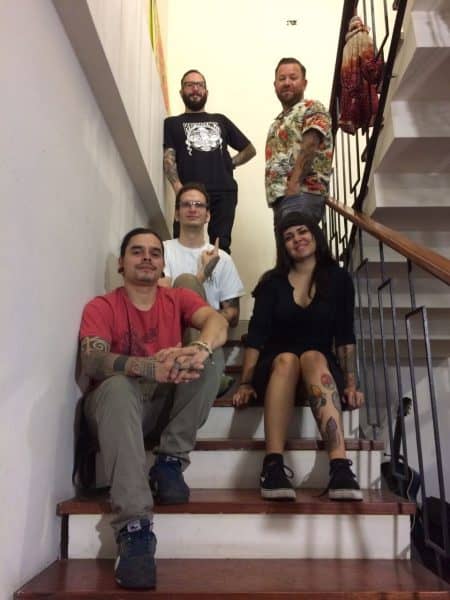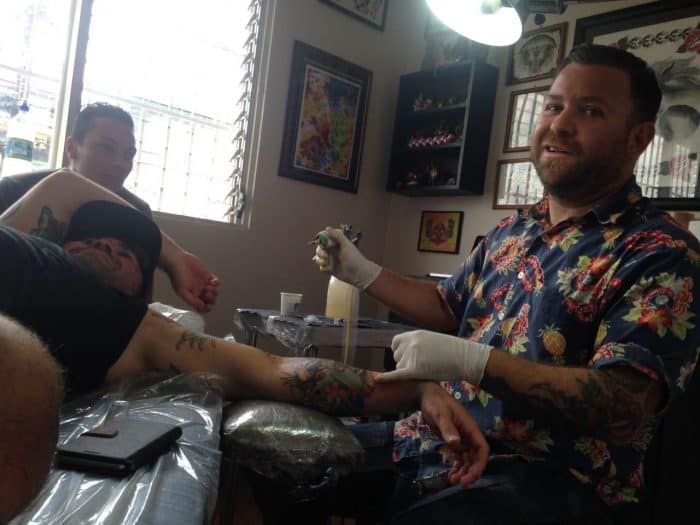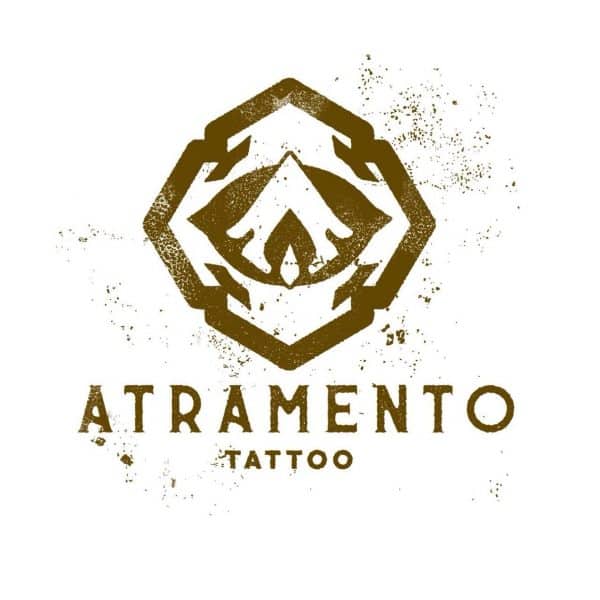Atramentum, or atrament, is a black substance that has been in use for millennia. In ancient Rome it was used as writing ink, as a dye for leather and as a varnish.
In Costa Rica, it’s also the name of a San José tattoo studio.
“We chose [the name] because black is the primary pigment we use when we make tattoos,” tattoo artist Daniel Ortiz told The Tico Times.
Ortíz joined his friends and fellow artists María José Campos, Manrique Vargas, Juan Vargas and Sebastián Montero in opening Atramento Tattoo a year and a half ago. All of them had been working in the field for different amounts of time, bringing varied art and graphic design studies as well as their travels into their designs. They decided to combine their talents by working together to provide the best possible experience for clients.
On a cold, rainy morning, The Tico Times sat down and spoke with Ortiz, Vargas, Campos, Montero, and Vargas at their beautiful studio in Barrio González Lahman in western San José, near the Italian restaurant Il Ritorno.
Excerpts follow.

Why did you decide to work together?
JV: I used to talk with Sebastián and Daniel about it years ago. We’d tattoo each other and each one of us traveled and then talked about it. There was always this idea about creating something together and working jointly. We had all worked separately, [so we thought]: why not work together?
DO: It’s about enriching [our skills] all together. Within this industry there’s no school or physical institution for learning, so each one of us travels or goes to a convention and brings back a different experience. The idea is that we can work here, live this lifestyle and share it with other people.
Why did you choose this house for the studio?
DO: It’s a very calm place and our clients love that. Also, we wanted to have a studio with an open space and a comfortable waiting room with a tranquil area nearby like this patio. Our working areas are very spacious for our own comfort and our client’s comfort. It’s better for them as they endure the pain of a tattoo session.
JV: Going to a studio is a bit intimidating; sometimes you feel like someone is watching you. The idea here is for people to have their own space while getting the tattoo done.
MV: We try to provide a kind experience. We burn some incense and have tea and other things so that they feel welcomed and relaxed… A tattoo is something important for the person getting tattooed, and even we [the artists] must have a nice experience. If we don’t have a nice experience, we’ll be uncomfortable with the piece even if it’s a good one. The experience is almost more important than the tattoo itself.
Which are your techniques and styles?
DO: I like to work with black and white with a more neo-traditional style and a bit dark, while always taking into account the name of the studio because black is our base. I like to do tribal styles and typographies in black.
MV: All of our styles are always changing and evolving. I mostly do geometry with pointillism, textures and a lot of black. Once in a while I do work with color, but I love to work with pure black ink, creating its different gradients. I also like mystic, Tibetan and Hindu art, everything that is spiritual. I often learn with clients about different spiritual things or symbols I didn’t know about before.
MJC: I like to work with a lot of colors and love cartoons. I love to make flowers.
SM: I was taught to do a bit of everything… I like the traditional tattoo [style]. These are designs that use a lot of black, thick lines, and few colors. They are very simple, yet loaded with energy.
JV: I’ve chosen to do things with a more Oriental style with black and white. However, lately I’ve been working with pointillism, geometry and tribalism [patterns].

How is the body a canvas?
MV: I’d say that it’s the most interesting canvas there is, because it’s alive and it moves. Most of the time the designs have a lot of movement precisely because of that. If you do something that’s very static without thinking about the movement of the body, it can look very strange.
MJC: It can even get frozen. For example, with an arm’s movement it can look particularly strange. That’s why you have to take that aspect into account. The first meetings with the client are very important: You’ve got to come to an agreement with the client about where they want their tattoo.
DO: You’ve got to remember that tattoos are a service. What they want is to communicate something: we just give them the tools for them to be able to communicate that and how they want to look for the rest of their lives. Those are very philosophical and intense things. You’re constructing something on a person’s skin, which is an organ that communicates with the exterior.

How has the stigmatization of people with tattoos changed in recent years?
SM: It has changed quite a lot. We have clients from a lot of different professions such as doctors, professors, and nurses. I’ve even tattooed religion professors. The mentality has been changing quite a lot and people are more open to it. They’re not seeing tattoos as something bad, as they did about twenty years ago.
MV: Actually, I’d say that the times in which it was seen as something bad was an abnormal time because tattoos have existed since the existence of humans. I’ve seen [old] photographs of royalty with tattoos of their family’s shield.
MJC: It’s a universal language understood here, in Europe or Asia. You actually learn and grow a lot through this.
Our “Weekend Arts Spotlight” presents Sunday interviews with artists who are from, working in, or inspired by Costa Rica, ranging from writers and actors to dancers and musicians. Do you know of an artist we should consider, whether a long-time favorite or an up-and-comer? Email us at kstanley@ticotimes.net.






